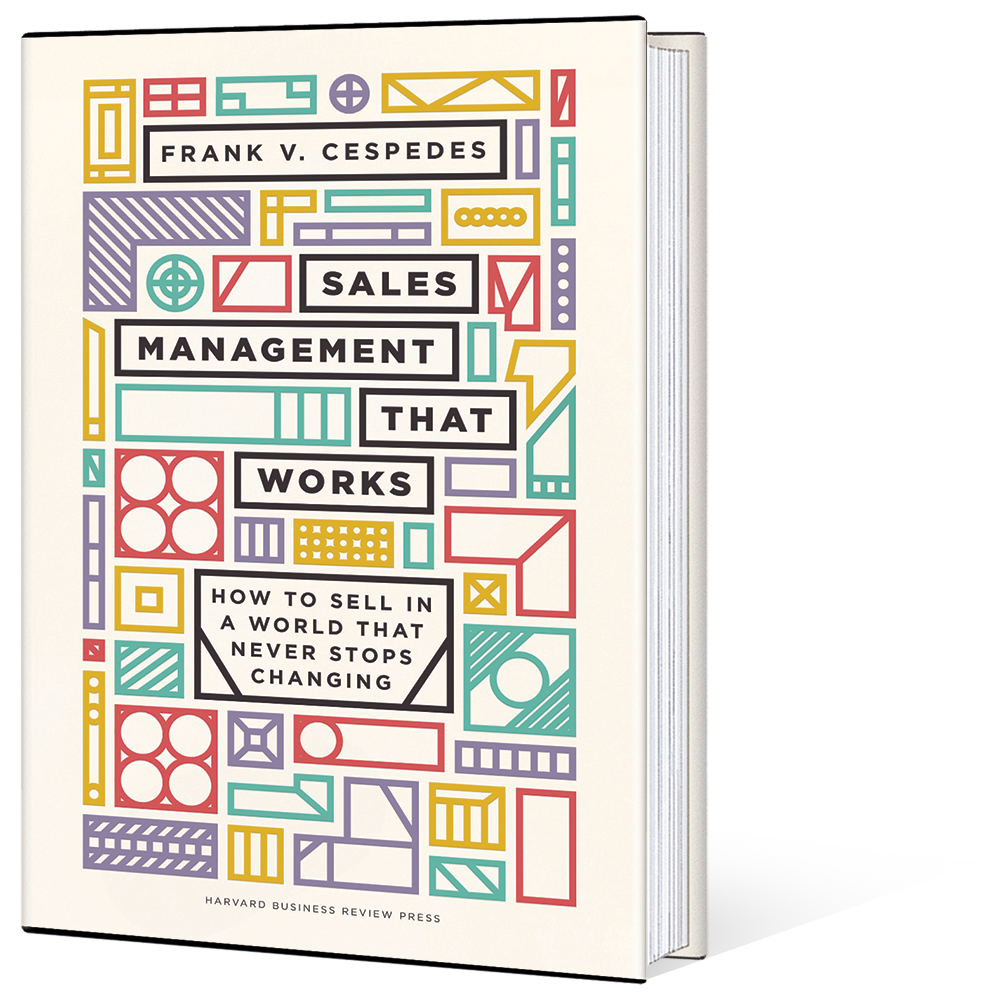Frank V. Cespedes (Top Sales Magazine, April 2018)
Someone once told me that many companies maintain their equipment better than their people. If so, they get what they don’t maintain. This is especially true in sales. Across industries, turnover in sales averages about 25-30% annually. This means that, at many firms, the equivalent of the entire sales force must be replaced and trained every four years or so. Any talk about talent management which ignores a requirement of that magnitude is just talk.
Despite what you currently hear about “big data” and “predictable revenue,” selling is not a science reducible to a few methodological rules that can be specified ex-ante. Many variables affect selling effectiveness besides the sales person: price, product, competition, market conditions, and so on. It’s your responsibility to adapt, not the market’s responsibility to be kind to your sales efforts.
But as the phrase implies, “sales reps” represent their organization to the market. They need reinforcement, periodic upgrading, adaptation of skills to changing circumstances, and the motivation that is a by-product of a good developmental process. Stated more bluntly, training salespeople (and other professionals who must deal with a range of changing situations) requires what the U.S. Air Force in training pilots calls the 8P’s: “Proper Prior Planning and Preparation Prevents Piss-Poor Performance.”
In my experience, effective sales training has certain foundational components, with implications for sales trainers, sales managers, and senior leaders at companies:
Build Your Team, Not another Firm’s Team. There’s no such thing as effective selling if it’s not linked to your firm’s strategy and objectives. So first focus on identifying the sales tasks required by the target customers and value proposition in your strategy.
Selling is a contextually determined set of skills: what works at that company does not necessarily work here, because sales effectiveness is a function of the sales tasks inherent in strategic choices. Chasing “best practices” can be counterproductive, and training firms have an incentive to apply their approach everywhere, whether or not particular circumstances are a fit with that approach. Beware of one-size-fits-all methodologies. Sometimes an off-the-shelf training tool can address the desired outcome. But more often, customization is required.
Develop the Fundamentals. Train salespeople with attention to actual behaviors that can be practiced and taught, not just preached via the football-and-war rhetoric that still dominates in many sales meetings. Core content in training should reflect knowledge about who buys, why, and how—today and tomorrow, not yesterday.
Selling is ultimately about the buyer. The fundamentals are driven by that fact. Up-to-date criteria for opportunity identification, relevant call patterns, active listening, understanding the customer’s business and translating your capabilities into customer business outcomes are typically core selling skills. But how those skills are developed and applied depends upon market conditions and the buying process in each segment. In an early-stage tech market, for example, customer education and applications development are often key sales tasks. But as the market develops and standards emerge, people typically spend more time selling against functionally equivalent products or developing third-party relationships. Training should keep pace with those task changes.
Experiential Learning. Selling is a performance art. Acquiring behavioral skills (versus concepts) requires repetition. People must try a new behavior multiple times before it becomes practiced enough to be comfortable and effective—anywhere from three to twenty times, according to different studies.
Hence, on-the-job learning is crucial. But in many companies, on-the-job training is a euphemism for no real training at all. It’s a random process dependent on a particular sales manager’s calendar, temperament, and ability. That’s a mistake. Adults learn best when they can repeatedly apply new information or a skill and see results—what some now call “deliberate practice.” Effective sales training cannot be a single event confined to a classroom or seminar. It requires feedback from interactions with customers. And as Sam Walton repeatedly told his people, “There ain’t many customers at headquarters.”
Follow-Up. The biggest developmental impact from training, according to many studies, is what happens after training sessions: follow-up and feedback. Too often, however, nothing happens after training initiatives. By contrast, effective sales training is linked to subsequent performance reviews, ride-alongs, win-loss analyses, and other core performance-management practices. In other words, sales managers must manage. They can’t “outsource” development of their people to a training event, no matter how well designed and executed that event may be.
Sales training at many firms still merits Hamlet’s critique of Elsinore Incorporated’s values statement: more honored in the breach than the observance. In a given year, over a third of firms do not train salespeople at all. And many budget training according to last-in-first-out accounting principles: training budgets (like advertising) increase when sales are good, and get cut when times are tough. So it’s hard to determine cause and effect. Sales training also affects other functions in a firm: each product manager wants her product emphasized; finance wants a shorter order-to-cash conversion cycle; operations prefers certain types of orders. So “a little bit of everything” is often a default option in sales training programs. But given the amount of money spent on sales by companies (an average of 10% of revenues across industries, and often more in B2B companies), executives have a fiduciary responsibility to manage and measure the people part of that investment more rigorously.



Trackbacks/Pingbacks